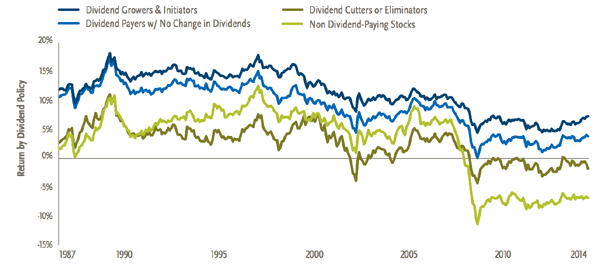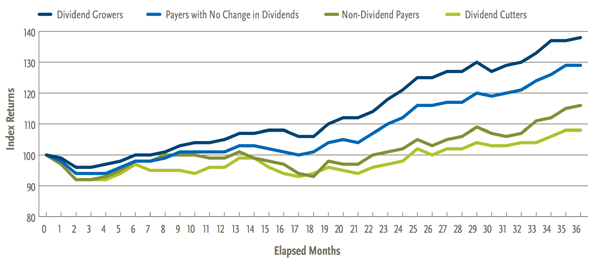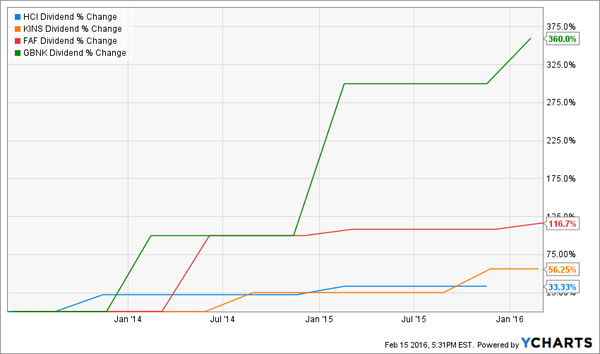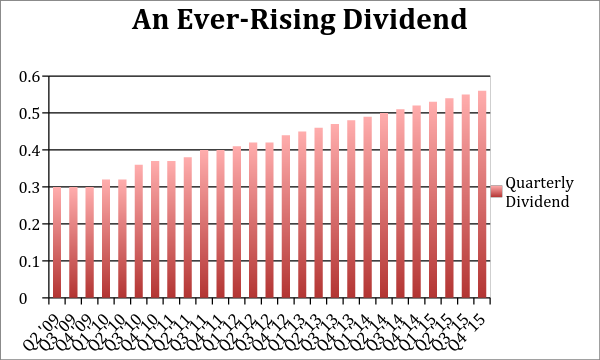It’s easy to beat the stock market – just buy stocks in companies that pay dividends, and boost their payouts every year.
While dividends help you “cash out” of your investment over time, the annual raises are what really make you money. Let me explain…
Even after a 15% pullback, the S&P 500 yields just 2.3% today. Which means if you buy an index fund today, and you never saw a dividend increase, it’d take you more than 40 years to get your initial investment back in cash.
Fortunately companies with growing earnings often do pass their higher profits along to shareholders. And you can really accelerate your returns by buying only those that increase their payouts annually.
According to Ned Davis Research, 80% of the total return of the S&P 500 since 1960 can be credited to the compounding and reinvestment of dividends. And since 1987, perennial dividend growers have returned 10.1%. They’ve outperformed static dividend payers, non-dividend paying firms, and dividend cutters or eliminators.
Dividend Growers Have Outperformed Since 1987

The interest rate environment doesn’t matter, either. Research from Nuveen shows that dividend growers outperform everyone else in the months after a Fed rate increase.
Dividend Growers Win After Fed Increases, Too

As with dividend payers, not all dividend growers are created equal. I require mine to have a steady track record of dividend increases, as companies that have consistently boosted payouts in the past are likely to continue doing so in the future.
Provided that business conditions cooperate, that is. So I also consider a firm’s payout ratio – dividends paid divided by profits – to see how easily the payments are being made. Generally anything under 50% is good, the lower the better.
And remember, there’s an actual business behind every ticker and quarterly payment. Potential dividend trouble (as we’ve seen with Kinder Morgan (KMI) and ConocoPhillips (COP) lately) is usually identifiable well in advance of any payout cuts – if you take the time to look behind the stated yield numbers.
Here are five firms that are growing their earnings and dividends much faster than the S&P 500 at large. They all pay a better-than-average dividend today, and have promising business prospects. Investors who buy these stocks today will likely soon enjoy an outsized yield on their initial investment, thanks to rapid payout growth.
First American Financial (FAF) provides insurance and services to homebuyers and sellers. The company is paying an all-time high yield at 2.9%, thanks to previous investor concerns about a slowing housing market. These worries now appear overblown after FAF’s strong earnings report last week, which sent the stock 10% higher in two days.
FAF started paying a dividend in 2010. Since then its increased its payout five times, or 333% overall. Earnings-per-share (EPS) increased 184% over the same time period (and remember, earnings growth drives dividend growth). The company just announced a 4% dividend hike, payable in March. If you believe the housing market is going to hold together, this is an attractive entry opportunity into FAF, which sports a payout ratio of 37%.
Guaranty Bancorp (GBNK) just announced its third dividend hike in the three years since the firm initiated its payout. Its current dividend is 360% higher than its 2013 variety, thanks in part to its most recent 15% increase.
GBNK pays 3% today. Future dividend hikes will require earnings growth, as the bank’s payout ratio is now up to 41%. But the company has 26 branches located in Colorado’s wealthiest and fastest growing areas, so customer demographics are on its side.
Kingstone Companies (KINS) is a lean 54-person operation that provides property and casualty insurance products to business and individuals in downstate New York. Founded in 1886, the firm has a good reputation that features a #1 out of 81 insurer rating by the Professional Insurance Agents Association in 2010.
KINS has doubled its dividend since it initiated the payout in 2011. The stock has a forward yield of 3.2%, and a payout ratio of just 21% that allows plenty of room for future increases. Its management team owns nearly 30% of the shares outstanding.
HCI Group (HCI) is another property and casualty insurer. As you might be noticing, insurance and banking are capital efficient industries that let well run companies return much of their earnings back to shareholders. There’s a reason why Warren Buffett loves them so much!
HCI pays out just 17% of its earnings in the form of dividends today. That provides plenty of room for the company to boost its already healthy 3.6% annual payout. HCI has tripled its payout since 2011, though its dividend has been cut three times since inception, as it’s dependent on how many claims the firm must pay out.
In December, HCI announced a $20 million stock repurchase program (over 5% of shares outstanding). Management itself has a 20% stake in the company.
Big Three-Year Dividend Growth

Finally Reliance Steel & Aluminum (RS) gives us an industrial name for our dividend growth portfolio. The firm pays 2.7% today, thanks to six dividend hikes over the last five years that have boosted the payout by 233%.
Steel prices haven’t been this low since the Great Recession, making RS an interesting contrarian play with some upside if the metals do rebound. The company has performed quite well considering its product pricing is in the tank.
My #1 favorite dividend grower doesn’t have to worry about lowering its pricing. It’s a healthcare firm that’s in high demand – one that’s boosted its payout for 13 quarters in a row, and counting:

With a track record like this, you’d think its stock price would have been bid up so high that its yield was quite low. Amazingly, that’s not the case – thanks to the rate hike panic of 2015 and the China panic of 2016.
This firm’s business is completely independent of both panics. In fact, it’s rock solid thanks to the biggest demographic shift in U.S. history – the retirement of 77 million baby boomers. Its stock yields an amazing 8.1% today, and the company just reported another quarter of outstanding earnings and a bullish outlook for 2016.
I don’t expect this stock to stay this cheap for very long, which means your opportunity to buy its ever-rising 8.1% yield is running out. Get the details on this dividend growth heavyweight and start profiting right now.
